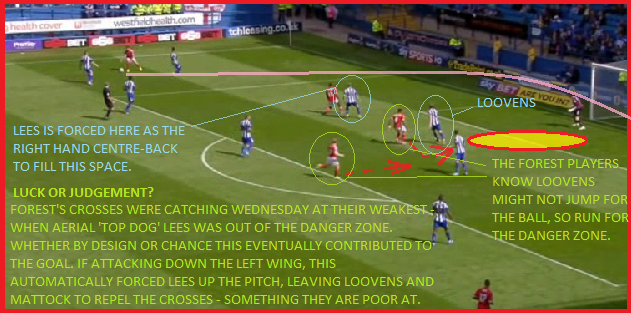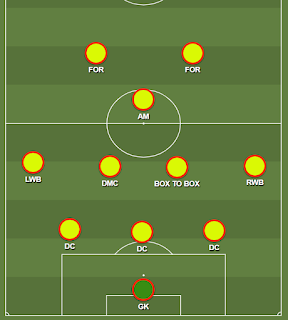Sheffield Wednesday 0 Forest 1
 Wednesday operate a physical, high-octane 4-4-2 system. I expected them to focus on hoofing the ball forwards to their target-man, Atdhe Nuhui; while the Austrian does receive a fair amount of direct play, our opponents did not base their game-plan around this and the amount of long balls they make is actually around average for the division.
Wednesday operate a physical, high-octane 4-4-2 system. I expected them to focus on hoofing the ball forwards to their target-man, Atdhe Nuhui; while the Austrian does receive a fair amount of direct play, our opponents did not base their game-plan around this and the amount of long balls they make is actually around average for the division.Indeed, they cut Forest open twice in the opening passages of play, as The Garibaldi were perhaps taken surprise by the enthusiasm of the home side, backed by a partisan crowd. The Owls could easily have been ahead were it not for a fantastic tackle by Michael Mancienne, and some wasteful finishing.
 The Reds looked
to have learnt their lesson from the Bournemouth game, fielding a five man midfield in what I deem a 4-2-3-1 system, pressing more conservatively than they have in other away games, instead trying to hit Wednesday on the break.
The Reds looked
to have learnt their lesson from the Bournemouth game, fielding a five man midfield in what I deem a 4-2-3-1 system, pressing more conservatively than they have in other away games, instead trying to hit Wednesday on the break.After initially looking shaky, Forest woke up and the system began to work. This is the second game already this season where home teams have come away with nothing after battering Forest - but although they did rely a little on luck, they ultimately deserved the points because they put in the effort to make their tactics successful.
 I've seen Saturday's formation referred to as a 4-4-1-1, 4-5-1 and a 4-3-3; this is a reflection of the flexibility the system gives in that essentially the 4-2-3-1 is several formations in one, as many of the players are basically playing more than one position - this has been the key to Forest's success so far this season, without playing their best football they have been out-working their opponents.
I've seen Saturday's formation referred to as a 4-4-1-1, 4-5-1 and a 4-3-3; this is a reflection of the flexibility the system gives in that essentially the 4-2-3-1 is several formations in one, as many of the players are basically playing more than one position - this has been the key to Forest's success so far this season, without playing their best football they have been out-working their opponents.When Wednesday had the ball, instead of pressing high Forest sat deep and pulled the wingers back (see diagram, above-right. Click to enlarge). This gave the coverage and security that two disciplined banks of four players provide.
But when in possession, this quickly changed into the classic 4-2-3-1 (see left), and as Forest sprang forward those tireless wide-men sometimes even overlapped the striker.
It is this willingness to play more than one role (and very importantly, when to do so) that has paid off for Forest. The two wingers have been the most important players in this regard - as illustrated in the two diagrams, but this has been a team philosophy. We've seen the full-backs flying forward as well as rarely going missing at the back, Andy Reid making himself available to receive the ball in his own half yet getting forward energetically, and it is also how Forest have managed to have so many players back defending when under pressure, and yet are able to spring forward so quickly.
 Stuart Pearce has instilled a real team philosophy of hard work and structured fluidity - the only players that really just do one task are the centre-backs and goalkeeper. It is the fact that this fluidity is structured that sets this game-plan aside from midfielders just being told to get forward. They, and their team-mates, know when this is going to happen, which is what makes this system a 4-2-3-1, and not just a 4-4-1-1 with the wingers told to make runs.
Stuart Pearce has instilled a real team philosophy of hard work and structured fluidity - the only players that really just do one task are the centre-backs and goalkeeper. It is the fact that this fluidity is structured that sets this game-plan aside from midfielders just being told to get forward. They, and their team-mates, know when this is going to happen, which is what makes this system a 4-2-3-1, and not just a 4-4-1-1 with the wingers told to make runs.This is how Forest have been able to pick up so many points without playing their best football. They haven't been lucky, they have been working very hard and taking advantage of a system of play which has taken over world football in the last 15 years, but is only recently filtering it's way down to this level.
Pearce's tactics may have ensured Forest were difficult to score against, but The Owls had a gaping hole in their tactics which Forest exploited; the aerial ability of Glenn Loovens.
 The Dutchman's partner in central defence is Tom Lees - a smaller, less powerful player but one who has excellent ability in the air. I had a theory that by attacking mainly down the left, Forest were deliberately sucking Lees away from the area where crosses would arrive (as the defence shuffles across to meet the pressure on one side, the closest centre-back automatically needs to drift towards the ball, see diagram, left). However Forest have tended to go down this side of the pitch a lot under Pearce - dragging Lees away may have been mere luck.
The Dutchman's partner in central defence is Tom Lees - a smaller, less powerful player but one who has excellent ability in the air. I had a theory that by attacking mainly down the left, Forest were deliberately sucking Lees away from the area where crosses would arrive (as the defence shuffles across to meet the pressure on one side, the closest centre-back automatically needs to drift towards the ball, see diagram, left). However Forest have tended to go down this side of the pitch a lot under Pearce - dragging Lees away may have been mere luck. For such a big man, Loovens is exceptionally poor at defending in the air. He has won only 4 aerial duels this season according to Whoscored.com, in contrast to his partner, Lees, who has won 26 so far. Forest will have known all this, so it's possible they targeted Loovens. The majority of their crosses came from the left into the area where Loovens and Mattock had the responsibility to defend.
For such a big man, Loovens is exceptionally poor at defending in the air. He has won only 4 aerial duels this season according to Whoscored.com, in contrast to his partner, Lees, who has won 26 so far. Forest will have known all this, so it's possible they targeted Loovens. The majority of their crosses came from the left into the area where Loovens and Mattock had the responsibility to defend.When ahead, Forest worked very hard to defend, often getting every player behind the ball, but their system ensured they were quick to disperse and still offered a threat going forward - meaning Wednesday, for all their pressure, could not totally set up camp in the Forest half. Forest usually had an outlet, giving our opponents something to think about.
 Along with the three advanced midfielders - who spent much of their time behind the ball but were ready to attack, Britt Assombalonga provided the best outlet; not only quick and strong, the youngster is clever on the ball and has good technique - he gave The Owls problems, ensuring they could not merely set up camp and besiege Forest into submission.
Along with the three advanced midfielders - who spent much of their time behind the ball but were ready to attack, Britt Assombalonga provided the best outlet; not only quick and strong, the youngster is clever on the ball and has good technique - he gave The Owls problems, ensuring they could not merely set up camp and besiege Forest into submission.The defenders were very strong. It was a real team effort - as mentioned earlier Forest were getting 10 or all 11 men behind the ball, and pressing selectively, blocking the path to goal through sheer weight of numbers, but special recognition should go to the men at the back, who dealt with the pressure calmly but with urgency.
The best player on the pitch was Karl Darlow; his quality has been unfairly doubted at times over the past year, but he showed during this game why he is a Premiership player in waiting, making a series of stunning saves.
But the most credit must (again) go to Stuart Pearce; he has galvanised (a word we will be hearing a lot I feel this season) the squad, brought in some real quality, and most importantly has them well organised and knowledgeable about their roles on the pitch. Psycho continues to prove his critics wrong.
Thanks for reading, thanks to www.whoscored.com for statistical help, and bring on the Derby!




Comments
Post a Comment